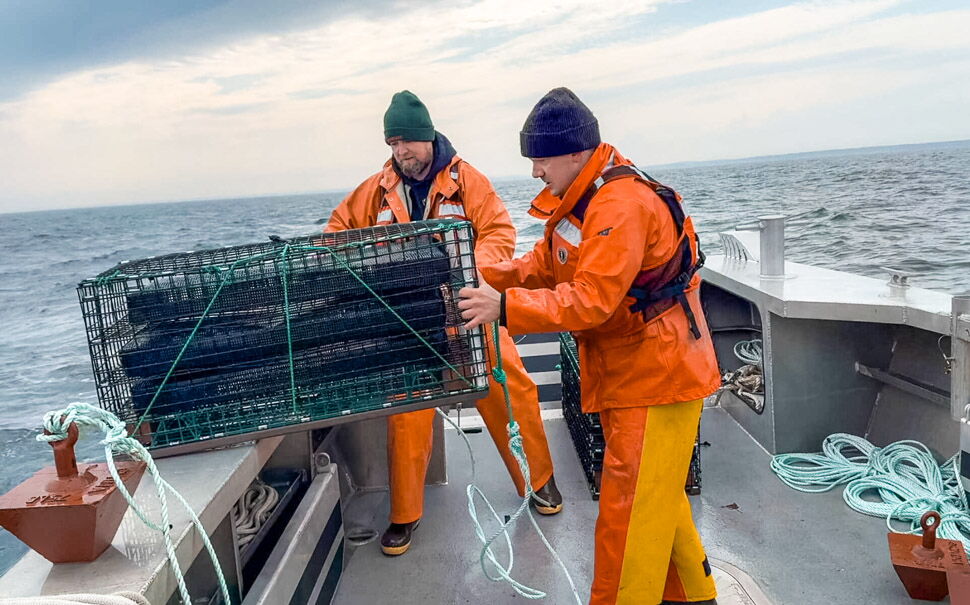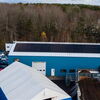
Gear for growing scallops is harvesting shellfish — and awards
 Photo / Courtesy of Seascale
Seascale, a Thomaston startup, makes a modular system for growing scallops.
Photo / Courtesy of Seascale
Seascale, a Thomaston startup, makes a modular system for growing scallops.
Earlier this year, a Thomaston startup that developed a new type of scallop farming grow cage scooped up $25,000 in cash prizes at a pitch competition held by Dirigo Labs in Waterville.
Seascale, founded by Charles Walsh and Jon Steuber, swept the competition’s three prize categories, receiving $20,000 as the judge’s Pitch Prize winner, $3,000 as the Founder’s Choice award and $2,000 by audience voting. The cash awards were sponsored by Skowhegan Savings Bank.

The company’s core innovation, the Maine Scallop Pot, is a modular aquaculture system designed to integrate into the routines of working fishermen, without disrupting daily lobstering operations.
“These prizes will help us expand operations and empower more coastal communities to build resilience through sustainable aquaculture,” said Walsh.
The Maine Scallop Pot is designed to be used around the daily rhythms of working lobstermen, enabling fishermen to cultivate scallops without adding labor-intensive tasks or disrupting established routines.
“We built the Maine Scallop Pot to make aquaculture a real, viable option for working fishermen, not just in Maine, but anywhere traditional fisheries are facing pressure,” said Steuber.
Scallop pot
The scallop growing gear Seascale developed looks like a lobster trap, hauls and sets like a lobster trap and can be stacked like traps.
But each is fitted with shellfish bags and is purpose built for growing scallops
With the tagline “Aquaculture integration for marine fishermen,” the goal is to provide high-quality, easy-to-integrate aquaculture gear that helps lobstermen add revenue streams without changing the way they fish, the company says.
Like lobster traps, the pots can be strung in trawls and set in different areas throughout the year to maximize productivity and to avoid conflict with lobster traps and scallop draggers.
Partnership development
Walsh grew up on the Maine coast and started his career cooking professionally and lobstering in the off season, while managing puffin and tern colonies for the U.S. Fish and Wildlife Service in the summer.
He spent the last decade scaling aquaculture production and developing sustainable seafood products for the retail and wholesale market. That included running the University of Maine’s experimental shellfish hatchery, scaling nursery and farm production of organic sugar kelp with Maine Sea Farms, growing oysters for Pemaquid Oyster Co. and building American Unagi’s processing and smokehouse operations.
Steuber has worked as a lobster boat stern man in the Knox County town of St. George since 2019. While commercial fishing, he helped his boat diversify income streams by expanding into kelp production.
He has 15 years of experience in partnership development, program design and implementation, and nonprofit management as the co-founder and former co-CEO of Valpo Surf Project, a youth mentorship and community development organization in Valparaíso, Chile. He continues to drive the organization’s growth as a member of its board of directors in the U.S. and Chile.
Startup takes root
The initial concept for Seascale and the Maine Scallop Pot started in August 2024 and was registered as an LLC with the state of Maine in September 2024, Steuber told Mainebiz.
The base of operations is in Thomaston — in a barn with no heat or electricity and with offices in Walsh’s living room and Steuber’s kitchen.
So far, each has invested about $2,000 in initial startup capital plus sweat equity working nights and weekends. Walsh and Steuber continue to work other jobs to pay the bills. Last fall, both were working at Pemaquid Oyster Co. in Damariscotta. The commutes and workdays “allowed ample time for discussing the design, implementation and business development for Seascale,” said Steuber.
The two continued to hatch plans while working for St. George carpenter and boatbuilder George Emery. Walsh continues to work on carpentry and boat projects while Steuber is working as a stern man for fisherman Gerry Cushman out of Port Clyde.
Financing
“We are currently bootstrapping Seascale’s operations through our own funds, generating some income through initial sales and pursuing some early grant funding,” said Steuber.
In addition to the founders’ seed capital and Dirigo Lab’s pitch awards, they’ve received mentorship and business education from Dirigo and its business accelerator program, support through in-kind consulting services and non-dilutive funding from others, including the Gulf of Maine Research Institute’s Blue Tech Boost Incubator program, in which they participated last fall; Maine Technology Institute’s Maine Entrepreneurial Resource Corps program and Maine Technology Institute’s Business Innovation Funding.
“We’ve also benefited from a variety of academic and nonprofit partners who have provided guidance and support in developing the company, including the Maine Aquaculture Innovation Center, the Brady Lab at University of Maine’s Darling Marine Center, Maine Sea Grant, Island Institute and Coastal Enterprises Inc.,” Steuber said.
Marketing
Mostly, marketing has been direct and relationship-based with fishermen, aquaculturists and researchers at trade shows like Maine Fishermen’s Forum, where the startup debuted the product, plus visits to wharves and docks and gear demonstrations.
“We also work with nonprofit and academic partners who help validate the pot’s performance in the field,” said Steuber. “Our website and social media presence support this hands-on outreach.”

Commercialization
While tests have been underway on the Maine Aquaculture Innovation Center’s experimental aquaculture lease site off in Walpole since October 2024, commercialization is just beginning with the recent completion of and a first manufacturing run of 100 units. About half will go to fishermen interested in diversifying into aquaculture or sea farmers for their existing aquaculture operations. About a quarter will be used for continued trials in a pilot program among lobstermen in Saint George.
Collaborating as a contract manufacturer, Thomaston-based lobster trap producer Brooks Trap Mill cut and bent the wire components and Seascale is completing final assembly before delivery.
Seascale has a provisional patent on the product design and will be submitting its application for a full patent within the year.
“In licensing this design to existing trap manufacturers within Maine, it will allow Seascale to scale and meet demand for the Maine Scallop Pot as adoption and implementation continues in the state,” he said.
The goal is not to become a manufacturer, but to license the design to existing lobster trap manufacturers.
“We don’t want to compete with existing manufacturers, but instead are interested in providing a diversified product for them to manufacture as there is fluctuation within the lobster industry,” he said.
There’s additional opportunity for expanding to other regions where trap fisheries are experiencing pressure and could benefit from diversifying income with the design, which is applicable for any commercial fishing boat with a hydraulic hauler, he continued.
“By using an intellectual property and licensing model, Seascale can morph its design to mimic the predominant form factor of the gear used by these other fisheries and license the designs to local manufacturers within those regions,” he said.
There’s also an opportunity in industries that cultivate other species such as urchins, hardshell clams and oysters, he added.










0 Comments